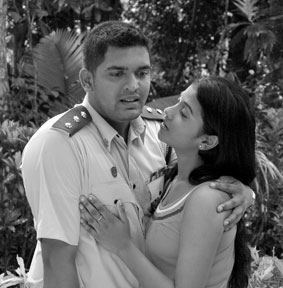Ira, Handa and Bennet
 "Peace is not mere absence of war, but is a virtue that springs from
force of character." "Peace is not mere absence of war, but is a virtue that springs from
force of character."
-Benedictus De Spinoza
Director Bennet Rathnayake has deftly wrenched a sizzling human
episode, off the ravaging swirl of the hideous conflict, that had
gripped the nation for over three decades.
Some classic war-films in the world cinema, made their appearance,
when the conflict was still raging. The simultaneity of war and films
made about it, served a specific and inescapable purpose. That is,
morale-building. They fortified the spirit of the combatants to fight
on. Again, they strengthened the resolve of the victimized masses to
endure the suffering and the privations of war.
In Sri Lanka, impactful war-films are making their entry, in the
slip-stream of the peace, achieved through Presidential initiatives. As
I see it, the end-aim of such films, is the reinforcing of the peace,
that is hard won, through the force of character.
Director Bennet Rathnayaka, limns his war-saga on a wide and complex
cinematic canvas, enabling the viewing masses to obtain a comprehensive
perspective on the conflict that plagued the nation for a generation.
"Ira, Handa Yata" (Under the Sun and the Moon) overwhelms the film-goer,
from the moment it begins to unfold on screen. When the viewer finds
himself fully immersed in the riveting detail of the war, recreated so
meticulously by the director and his men, his critical faculties tend to
be in abeyance - at least for the time being. The readily available
phrases gush into the mind - 'breath taking,' 'spell-binding' etc. These
expressions of felicitation, fit neatly to the initial phase of the
film, with an impressive aptness.
 |
|
A scene from the film
|
The introductory portrayals of war, with its tensions, confusion,
anxiety and disarray, are recorded almost realistically. The initial
cinematic statement is so authentically communicated, that it exudes the
"feel" of an emotionally moving documentary.
As the unmistakable upshot of all this, cinematographer Kalinga
Deshapriya, is immediately catapulted to the status of a "hero", behind
the camera. Once again, kudos goes to director Bennet Rathnayaka for his
daring choice of this fresh talent, for his epic production.
Cinematographer Kalinga Deshapriya, sustains the compelling effect of
his camera, upto the last frame of the film. What he has been able to
win, through the dextrous wielding of his versatile camera, distinctly
earns him a star-rating in "Ira Handa Yata."
Let us focus on the central personality of this whole affair -
Director Bennet Rathnayaka. What did he have to work with? The throbbing
urgency of the war-theme, has, by now, worn off to a great extent. The
relentless and gruesome terrorism has been comprehensively eradicated in
a legendary victory. The masses have begun, slowly but steadily, to
settle down to a tenor of life, full of hope about a promising future.
The shock and the alarm of the sudden explosion of bombs, have abated.
In such a context, where can a director discover the drama of war?
Given such a scenario, director Bennet Rathnayaka, would certainly
have confronted an excruciating creative frustration. What enticing
shape could he impart to his war-film? He had to discover a plot-line,
that the viewer could cling on to. Overcoming all these hesitations and
perplexities, director Bennet Rathnayake opted to tread a cinematic path
through this morass of war. The fact, that he has negotiated his chosen
cinematic trail, with impressive efficiency, has been amply proved by
the diverse international encomia he has so far been able to win.
His film concentrates on the pulsating human warmth and the moving
human sensations that emerge through the blood-soaked, heart-rending
violence of war's torments.
The prime location of the film "Ira, Handa Yata", is terrorist
territory. There, tortures and violence are routine. The camera,
detaching itself from those harrowing scenes, focuses upon an intimate
human drama. Major Mahasen, near fatally wounded in combat, is fast
losing his grip on life. But, his companion Corporal Rakhita, shields
him, with no thought whatsoever about his own existence. While out
scouting a safe haven for the wounded major, the selfless Corporal
Rakhita (Udara Rathnayaka) is nabbed by the terrorists.
The Corporal reveals the whereabouts of the wounded Major to his
captors entirely in the hope that his captors will take him as a POW,
and would bring him back to health.
But, what actually takes place is disastrously unexpected. The fully
recovered Major Mahasen (Saumya Liyanage) confronts a terrorist boss.
When the Major flatly refuses to toe the line dictated by the terrorist
leader, he is shot dead, point blank.
Major Mahasen's tragic end, engenders a vast sense of guilt, within
Corporal Rakhita.
Director Bennet Rathnayake, structures his plot-line, utilising
Rakhita's deep sense of guilt, as the dynamic force, that propels the
story forward.
To make amends, Corporal Rakhita embarks upon a harrowing effort to
console the grieving widow of the Major and his sorrow devastated
family. The ensuing series of flashbacks, provides the elucidatory link
the viewer urgently to tie the various strands of the story together.
It is here that some of the major characters emerge into articulated
profile. The viewers experience afresh the love affair between Major
Mahasen and the Tamil maiden Kiruba Devi in the refugee camp. Tasha
Darshani in her portrayal of Kiruba Devi, turns in a multi-layered
performance. As a vivacious young woman, she becomes the wife of the
young "enemy" Major. In the absence of her husband who is out there at
war, she has to endure a constant dose of tongue-lashings from her
mother-in-law, to whom Kirula is the source of all evil, that befell her
household. Once again, the debut actress Tasha Darshani is a felicitous
discovery of director Bennet Rathnayaka.
The soothing lyrics of the film, may have, perhaps, been introduced
by the director, as a counter-point to the pervading, heart-searing
violence, that his cinematic work has to dwell on most of the time.
Although a keen critic or a discerning film-goer may detect some
stray glitches or minor hiccups in some instances, over-all director
Bennet Rathnayaka's "Ira Handa Yata" is a triumphant cinematic
achievement. Director Bennet Rathnayaka was inspired by a deep seated
cinematic philosophy. After one of the bloodiest chapters in our Dharma
Dvipa (The Isle of Righteousness) the director set out to prove
cinematically, that love, humanity, natural understanding and compassion
have no limit or end. In a tear-soaked plea, the major's mother (veteran
actress Suwineetha Weerasinghe) lets out a cry, emanating from the deep
recesses of her being: "This child is ours." In a land, with a war-torn
past, that is the voice, that should guide future.
"Ira, Handa Yata" conveys an unforgettable film-metaphor, that will
remain deeply etched in the souls of cinema-goers. A group of young
children, rides along in unabashed glee, under the arches of a bridge.
The glory of liberty is emphatically symbolized in this cinematic
moment. Director Bennet Rathnayaka has made his philosophic statement,
in this eloquent cinematic expression.
|

